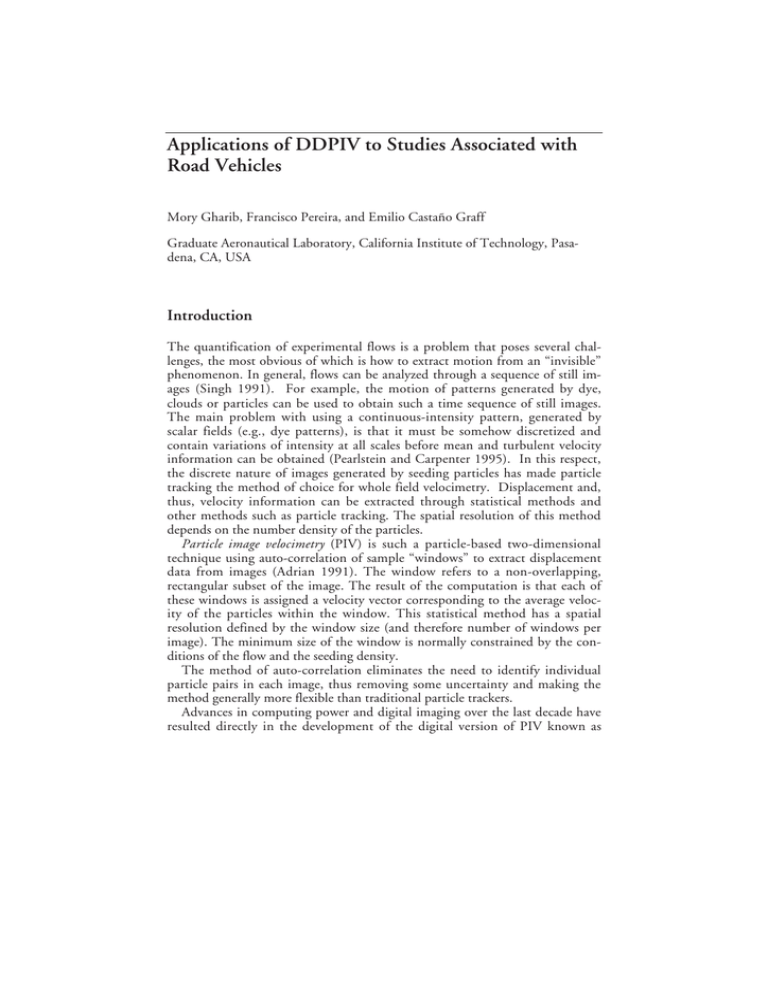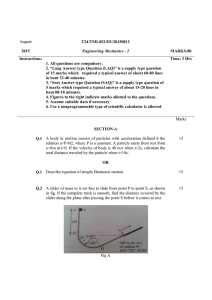Applications of DDPIV to Studies Associated with Road Vehicles
advertisement

Applications of DDPIV to Studies Associated with Road Vehicles Mory Gharib, Francisco Pereira, and Emilio Castaño Graff Graduate Aeronautical Laboratory, California Institute of Technology, Pasadena, CA, USA Introduction The quantification of experimental flows is a problem that poses several challenges, the most obvious of which is how to extract motion from an “invisible” phenomenon. In general, flows can be analyzed through a sequence of still images (Singh 1991). For example, the motion of patterns generated by dye, clouds or particles can be used to obtain such a time sequence of still images. The main problem with using a continuous-intensity pattern, generated by scalar fields (e.g., dye patterns), is that it must be somehow discretized and contain variations of intensity at all scales before mean and turbulent velocity information can be obtained (Pearlstein and Carpenter 1995). In this respect, the discrete nature of images generated by seeding particles has made particle tracking the method of choice for whole field velocimetry. Displacement and, thus, velocity information can be extracted through statistical methods and other methods such as particle tracking. The spatial resolution of this method depends on the number density of the particles. Particle image velocimetry (PIV) is such a particle-based two-dimensional technique using auto-correlation of sample “windows” to extract displacement data from images (Adrian 1991). The window refers to a non-overlapping, rectangular subset of the image. The result of the computation is that each of these windows is assigned a velocity vector corresponding to the average velocity of the particles within the window. This statistical method has a spatial resolution defined by the window size (and therefore number of windows per image). The minimum size of the window is normally constrained by the conditions of the flow and the seeding density. The method of auto-correlation eliminates the need to identify individual particle pairs in each image, thus removing some uncertainty and making the method generally more flexible than traditional particle trackers. Advances in computing power and digital imaging over the last decade have resulted directly in the development of the digital version of PIV known as 132 M. Gharib, F. Pereira, and E.C. Graff Digital Particle Image Velocimetry, or DPIV (Willert and Gharib 1991, Westerweel 1993). Some extensions of traditional DPIV can be utilized to obtain three components of the velocity field, but only a few planes at a time. Holographic PIV techniques are suitable for obtaining the three-dimensional (3D) distribution of the velocity vector field (Barnhart et al. 1994), but their photographic nature limit their ability to address the temporal dynamics of turbulent flows. Recent advances in 3D video-based particle tracking techniques have removed some of these shortcomings (Kasagi and Sata 1992), but most of these systems require arduous alignment of multiple cameras and other optics, and also require calibration and extensive processing. An emerging technology that has a good potential for resolving difficulties associated with the aforementioned flow mapping techniques is the method of defocused imaging: Defocusing Digital Particle Image Velocimetry (DDPIV) (Willert and Gharib 1992). It is the natural extension of planar PIV techniques to the third spatial dimension. DDPIV can perform the same flow quantization that DPIV can – but in a volume rather than a plane, and thus can extract more information than stereo techniques. The illumination of a volume also increases the ease with which such a system can be set up for a particular experiment. For PIV measurements the system does not require calibration and camera alignment has to be performed only once, also reducing downtime. The Defocusing Concept Fig. 1. The defocusing concept: a) standard, one aperture system, b) defocusing, multiple aperture system. Applications of DDPIV to Studies Associated with Road Vehicles 133 The foundations of the defocusing concept were established in an early paper by Willert and Gharib (1992). We report here the most important aspects in a revised form. For clarity, we will use the term particle when referring both to a solid (or liquid) particle and to a bubble. A typical 2D imaging system, consisting of a converging lens and of an aperture, is represented in Fig. 1 to help describe the Defocusing Digital Particle Image Velocimetry (DDPIV) technique. Fig. 1a exhibits a point A, located on the object plane (or reference plane), and a point B placed in between this plane and the lens system. Point A appears focused in A', on the image plane (or sensor plane), while B is projected as a blurred image B'. The DDPIV technique uses a mask with two or more apertures shifted away from the optical axis to obtain multiple images from each scattering source, as shown in Fig. 1b. The image shift b on the image plane, caused by these off-axis apertures, is related to the depth location of the source points, whereas the scattered light intensity combined with the blurredness is used to recover the size information. Geometric Analysis Fig. 2. A simplified version of the defocusing method A simplified geometric model of a two-aperture defocusing optical arrangement is represented in Fig. 2. The interrogation domain is defined as a cube of side a, thus a square in the plane. The back face of this cube is on the reference plane, which is placed at a distance L from the lens plane. Let d be the distance between apertures, f the focal length of the converging lens and l the distance from the lens to the image plane. The image plane is materialized by a photo sensor (e.g. CCD) of height h. The physical space is attached to a coordinate system originating in the lens plane, with the Z-axis on the optical axis of the system. Coordinates in the physical space are designated (X,Y,Z). The image coordinate system is simply the Z-translation of the physical system onto the 134 M. Gharib, F. Pereira, and E.C. Graff sensor plane, i.e. at Z = -l. The coordinates of a pixel on the imaging sensor are given by the pair (x,y). Point P(X,Y,Z) represents a light scattering source (a particle). For Z≠ L, P is projected onto points P'(x',y') and P''(x'',y''), separated by the distance b. The coordinates (x',y') and (x'',y'') of the images P' and P'' of P(X,Y,Z) in the image plane are given by the following relations: (1) Where M is the optical magnification provided by the lens equation. The image separation vector b represents the distance between the images P' and P''. The norm is therefore given by (2) Equation 2 demonstrates the extreme simplicity of the defocusing concept, which of course is greatly valuable in terms of computational implementation and processing speed. In purely geometric terms, the image separation b is independent of the in-plane coordinates X and Y. Likewise, the pinhole diameter has no bearing on b and is only responsible for the amount of blurredness of any given particle image. For our prototype instrument, we use three pinholes, arranged into a triangular pattern. This configuration, shown in Fig. 3, exhibits an inverted triangle when P moves across the reference plane and requires straightforward and fast image processing routines. Fig. 3. A three-aperture defocusing arrangement. Applications of DDPIV to Studies Associated with Road Vehicles 135 The sensitivity of the system, i.e. its ability to detect small changes of the particle location, can be evaluated through the separation gradient (3) The coordinates of P in the world coordinate system are derived from the image coordinates of the projections P' and P'' (see Eq. 1) (4) Assuming that the apertures are equidistant from the origin of the coordinate system, the image point defined by (x0,y0) is the image of the particle if there were a single aperture at the origin. A camera system has been designed and fabricated based upon the above concept. The specific characteristics of this instrument can be found in the paper by Pereira et al. 2000. The velocity vector field is obtained by local spatial cross-correlation between small volume elements (voxels, equivalent to windows in DPIV) containing particles observed at two time steps, as shown and discussed by Pereira et al. 2000. Applications The nature of the DDPIV system makes it very versatile. Its ability to resolve complex flows and perform particle sizing in 3 dimensions makes it a useful tool in many aspects of the design of road vehicles. Exterior flow measurements require, in most cases, that the flow be seeded with particles. For use in heavy fluids, such as water, there is a large selection of appropriate solid particles. For lighter fluids, such as air, one is not limited to solid particles. The whole system can be used in a laboratory environment (e.g. wind tunnels, water tunnels, tow tanks) and, with relative ease, can be taken to the field (full-scale on-road tests). A system can be designed to measure a range of different probe volumes that requires no tedious alignment. Moreover, it is compact and can be transported in one unit which allows for fast set-up times. Spray-type flow measurements can be performed, in some cases, more easily than exterior flows, since the spray itself will form the particles – there is no need to seed the spray to perform measurements. This provides great advantages, since in most cases the part or component’s performance can be visual- 136 M. Gharib, F. Pereira, and E.C. Graff ized and quantized with the actual fluid that would flow through it. For instance, experiments can be performed on injector-cylinder combinations, performing velocimetry and particle sizing on the actual fuel that would be used in a final production model. Fig. 4. A truck model in the water tunnel with the probe volume illuminated. Other spray applications include water spray and splash from the vehicle in wet-road conditions. Detailed information on how a vehicle spray patterns from driving through large water puddles or evenly wet roads is fundamental in the development of road-friendly vehicles and tire designs that do not impose an unsafe, low-visibility environment on other vehicles and pedestrians. Internal flow measurements are almost no different from those for exterior flows, except for the main requirement that the probe volume must be optically accessible for both illumination and imaging. The DDPIV system has great potential in vehicular components for cooling, intake, exhaust, and other components where flow characteristics contribute in large part to the performance and efficiency of the vehicle. To demonstrate the DDPIV system’s ability to evaluate complex flows (with both PIV and particle sizing functionality), we consider two cases of a model propeller immersed in a water tank, one propeller having 2 blades, the other having 3 blades. The two-blade model propeller is immersed into a water tank. The rotation speed is 12 rps, corresponding to a tangential velocity of 2.52 m.s-1 at the tip of the blades. A bubble generator is placed below the propeller, producing a dense Applications of DDPIV to Studies Associated with Road Vehicles 137 stream of rising sub-millimeter air bubbles. The velocity field is obtained through phase averaging. Fig. 5. Pathlines of “mass-less” bubbles around the propeller. A 3-D velocity field is obtained after averaging and outlier correction. Outlier correction is a smoothing algorithm directly evolved from DPIV, whereby constraints can be set so that the magnitude of a particular vector is not drastically different from that of its nearby neighbors. By computationally injecting “mass-less” particles into the mean velocity data set in a radial arrangement and one diameter upstream the propeller, pathlines can be generated, providing a unique insight into this complex flow as shown in Fig. 5. Gray level relates to the local measured velocity amplitude. Velocity reaches a maximum of 2.49 m.s-1 in the outer region of the propeller, matching closely the blade tip tangential velocity. 138 M. Gharib, F. Pereira, and E.C. Graff Fig. 6. Bubble size vs. longitudinal distance (left) and bubble population vs. size (right). The (real) bubble mean radius along the Y vertical axis of the flow (rotation axis of the propeller) is reported in Fig. 6 (left). The mean radius increases almost linearly to almost 325 µm at Yª30 mm, where the propeller is located. After the bubbles pass the immediate vicinity of the propeller, the radius is found to follow the opposite trend, decreasing to about 200 µm. The growth of bubbles is due to a very small extent to the decrease of the static pressure with increasing Y. In fact, bubbles experience first the low pressure in the suction side of the propeller before reaching the high-pressure region where they collapse. Included in Fig. 6 (right) are the histograms calculated taking the same volume below and above Y=30 mm. The histogram peak follows the trend outlined before due to the pressure variations. The ratio of the upstream to the downstream populations is 65%. However, the ratio of the respective void fractions is close to 100%. These observations indicate that coalescence of bubbles is the main mechanism acting here, although breakup may occur in the immediate vicinity of the propeller. A three-blade boat propeller is the second case. A similar configuration is used here. The propeller is rotated at 12 rps. The velocity field represented in Fig. 7 is obtained by phase-averaging a sequence of 50 instantaneous velocity fields. Spurious vectors can be seen on borders of the interrogation domain. A slice in the velocity field, as shown in Fig. 8, clearly displays the high speed jet core along the downstream section of the propeller axis. However, the isovelocity contours displayed in Fig. 9 show a viscous wake that appears as a velocity defect due to the merging of the two boundary layers from the blades. A slight contraction of the slipstream could also be detected. The wake is found to rapidly fade into the bulk flow. Applications of DDPIV to Studies Associated with Road Vehicles Fig. 7. The 3D Velocity field of the three-blade propeller Fig. 8. Velocity cross-section in the downstream region 139 140 M. Gharib, F. Pereira, and E.C. Graff Fig. 9. Isovelocity contours corresponding to Fig. 8. Acknowledgements We would like to thank the Office of Naval Research (contract N000140010110) for their continuing support in the development of this technology. The Defocusing Digital Particle Image Velocimetry (DDPIV) technology is protected under a U.S. patent through the California Institute of Technology. References Adrian, R. J., 1991, Particle-Imaging Techniques for Experimental Fluid Mechanics, Annual Review of Fluid Mechanics, Vol. 23, pp. 261-304. Barnhart, D.H., Adrian, R.J. and Papen. G.C., 1994, Phase-conjugate Holographic System for High Resolution PIV, Applied Optics, Vol. 3, No.30, pp.7159-7170. Kasagi, N., and Sata. Y., 1992, Recent Development in Three-Dimensional Particle Tracking Velocimetry, Proceedings of Flow Visualization Conference VI, Yokohama, Japan. Pearlstein, A.J., and Carpenter, B., On the Determination of Solenoidal or Compressible Velocity Fields From Measurements of Passive and Reactive Scalars, Physics of Fluids, Vol. 7, No 4, pp. 754-763, 1995. Applications of DDPIV to Studies Associated with Road Vehicles 141 Pereira, F., Gharib, M., Modarress, M., and Dabiri, D, 2000, Defocusing DPIV: A 3-component 3-D DPIV Measurement Technique, Application to Bubbly Flows, Experiments in Fluids, Vol. 29. Singh, A., Optic flow computation, IEEE, Computer Society Press, 1991. Westerweel, J., 1993, Digital Image Velocimetry: Theory and Application, Delft UP, Delft, Netherlands. Willert C. E. and Gharib, M., 1992, Three-dimensional particle imaging with a single camera, Experiments in Fluids, Vol. 12, pp. 353-358. Willert, C., and Gharib. M., Digital Particle Image Velocimetry, Experiments in Fluids, Vol. 10, pp. 181-183, 1991.






